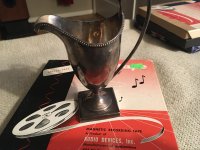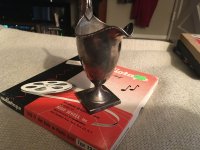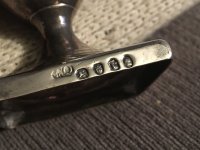bigcaddy64
Hero Member
I picked up this little guy (just at 6” high) at a garage sale this past Saturday with a few other small pieces of slightly more modern Sterling.
at first glance, it had the color of plate but the more I looked, the more the age of the piece became obvious, as well as the
possibility of it being Sterling. After seeing the hallmarks, I figured it was worth the 2 bucks and I bought it.
last night I spent a bit of time looking through silverplate and Sterling hallmarks with no real luck. The closest I found was Timothy Oliphant but he’s in the wrong city.
Since I’m not familiar with the rules on English hallmarks, I don’t know if this piece is 1792 or 1832. The marks are out of the correct order presented on the date charts and I don’t know what that indicates.
I can see small tool marks, file marks, etc which are good indicators its truly a very old, hand wrought piece from overseas.
Is anybody a bit more familiar with these marks or how to correctly interpret them. The closeup photos should help.
at first glance, it had the color of plate but the more I looked, the more the age of the piece became obvious, as well as the
possibility of it being Sterling. After seeing the hallmarks, I figured it was worth the 2 bucks and I bought it.
last night I spent a bit of time looking through silverplate and Sterling hallmarks with no real luck. The closest I found was Timothy Oliphant but he’s in the wrong city.
Since I’m not familiar with the rules on English hallmarks, I don’t know if this piece is 1792 or 1832. The marks are out of the correct order presented on the date charts and I don’t know what that indicates.
I can see small tool marks, file marks, etc which are good indicators its truly a very old, hand wrought piece from overseas.
Is anybody a bit more familiar with these marks or how to correctly interpret them. The closeup photos should help.







